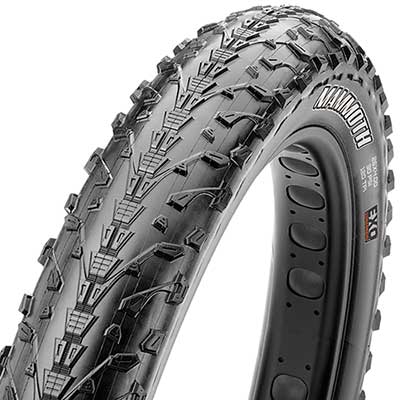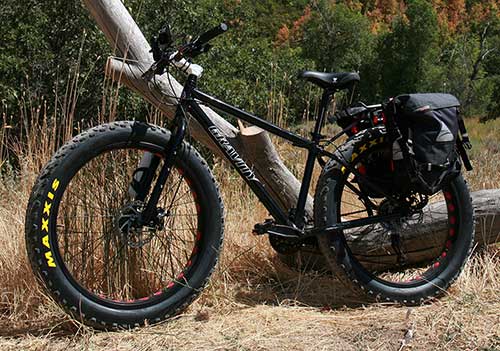Maxxis was kind enough to provide a pair of their Mammoth 26×4.0 tires for my fat bike project. I put them on late in the winter, and rode them well into summer. So consider this a two-season review. Because Utah pretty much only has snow, or 100 degree heat.There is not much in between.
The Mammoth is a full 4 inch wide (lug to lug) tire. I got the 120 tpi version with the EXO sidewalls for some cut protection. At 1,270 grams, they’re not light. But they are a huge weight savings over the stock tires that came on my bike. If I trust manufacturer specs, I’ve cut about a pound of rotating weight off each wheel. And based on how it steers, that seems to be true.

While I got these tires with snow in mind, their design makes them a good all around tire, doing better in some places than others. The tread design places a nearly continuous row of blocks down the center, smaller lugs to either side, then back to some bigger lugs on the edges. This makes them roll fast in a straight line, but still have plenty of bite in the corners. Though they are rated for up to 30 PSI, I never ran them higher than 20.
At 6 or 7 PSI, I could roll along the sandy “beach” at a nearby lake. For snow, I doubled the front pressure, and ran the back at a full 20 PSI. The big problem with where I was riding (fresh powder over a solid base) was that the snow would suddenly give way to icy patches. At times like this, I would be wishing for less air, and maybe a couple hundred screws. Other than that, traction was great. In mud, they don’t pack up, which is good. Unless you don’t have fenders, in which case it sucks, as they fling mud like an angry kid. Should you decide to cut across a field of wet grass, don’t even think of leaning into a turn at speed. There was a brief moment of regret, followed by impact.
In drier conditions, they kept me upright, and gave me plenty of confidence to tackle everything with as much speed as I could muster. Most of my trails are powdery dirt over a hard base, with lots of rocks. The Mammoth sticks well here, and even on looser dirt, you can run fast and fearless. I’m not a fast rider on a fat bike, but when I got this fatty, I recall thinking that the entry level brakes were fine for the speeds I would attain. Now I’m seeing that a brake upgrade may be in order, to keep pace with the Mammoth tires.

Overall, I’ve been more than happy with the performance of the Maxxis Mammoth tires. They worked well in the Utah snow, and as things warmed up, I found they are even better than expected over hardpack or even a bit of loose mud. The EXO sidewalls show some abrasions, and the tread refuses to wear down. Goat head flats are miserable, but I feel like it’s because there is twice as much rubber exposed to them.
MSRP for these tires run from $95-125, but don’t be afraid to shop around. While you should always hit up your local store first, if they don’t carry them, some good deals can be found online.
So did Maxxis name their Mammoth after the extinct member of the elephantidae family, or did they choose it because it has meant “really big” for the last couple hundred years? Well, the mammoth roamed where it wanted. They could be found high in the mountains, but had no trouble crossing rivers in the lower regions, and could traverse all sorts of soil thanks to their large footprint. They survived the coldest winter cold with ease. And yes, they were huge. So maybe it’s a bit of both. maxxis.com
Brian